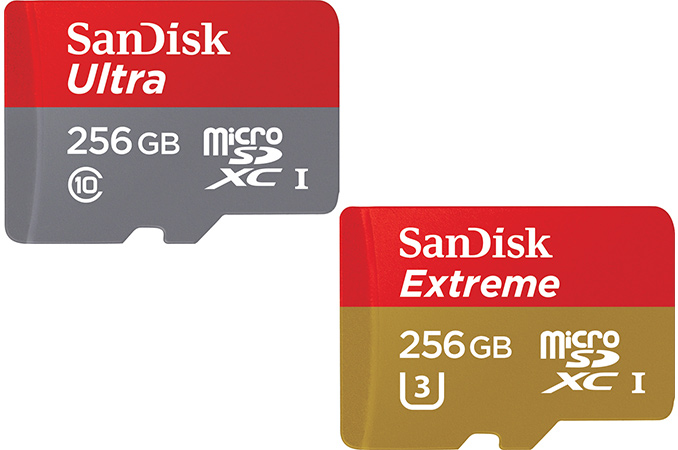Western Digital Rolls Out 256 GB SanDisk microSDXC Memory Cards
by Anton Shilov on June 28, 2016 9:00 PM EST- Posted in
- Memory Cards
- NAND
- SanDisk
- microSDXC

Coinciding with the Mobile World Congress at Shanghai, SanDisk owner Western Digital is introducing two new microSD memory cards that can store up to 256 GB of data. The new SanDisk-branded cards are designed for smartphones, tablets and content-capture devices. The capacities are akin to those of mainstream SSDs, albeit at a higher price.
The new 256 GB memory cards from Western Digital are the SanDisk Extreme microSDXC as well as the SanDisk Ultra microSDXC Premium Edition. Both cards use the UHS-I interface which supports transfer rates of up to 104 MB/s. Compatibility with existing microSDXC and microSDHC devices is retained, but, obviously at lower speeds.
The SanDisk Extreme microSDXC supports read/write speeds of up to 100/90 MB/s, while the SanDisk Ultra microSDXC Premium Edition is slightly slower and features transfer speeds up to 95 MB/s. The Extreme card also has higher minimum sequential write speed - 30 MB/s vs. 10 MB/s, which is important for recording high-bitrate 4K videos.
| SanDisk 256 GB microSDXC Cards at Glance | |||||
| SanDisk Extreme microSDXC | SanDisk Ultra microSDXC Premium Edition | ||||
| Read Speed | up to 100 MB/s | up to 95 MB/s (?) | |||
| Write Speed | up to 90 MB/s | up to 95 MB/s | |||
| Minimum Sequential Write Speed | 30 MB/s | 10 MB/s | |||
| Interface | UHS-I | UHS-I | |||
| Availability | Q4 2016 | August 2016 | |||
| Price | $199.99 | $149.99 | |||
Like other high-end Secure Digital cards, the new 256 GB microSDXC products from Western Digital are waterproof, temperature-proof, shock proof, and X-ray proof, which is useful for those who travel a lot and/or have to use memory cards in harsh conditions.
Western Digital’s SanDisk 256 GB microSDXC cards will not be alone on the market and will compete against Samsung’s EVO Plus 256 GB microSDXC card introduced in May. The latter also features a UHS-I interface and transfer speeds up to 95 MB/s. To build such card, Samsung had to use its 3D V-NAND memory. Meanwhile, SanDisk has not yet disclosed what type of NAND flash it uses to build its high-capacity memory cards.
The 256GB SanDisk Ultra microSDXC UHS-I Premium Edition card will be available worldwide in August 2016 for $149.99. The faster 256GB SanDisk Extreme microSDXC UHS-I card will be available in Q4 2016 for $199.99.
Source: SanDisk














30 Comments
View All Comments
jabber - Wednesday, June 29, 2016 - link
Yeah these are good for Chromebooks too. Especially with the Google Play store on the way.cm2187 - Wednesday, June 29, 2016 - link
Are we expecting all devices compatible with 128gb cards to be able to use it or is the 128gb also a compatibility limit (like some devices can only use 32gb micro sd cards)?tiro_uspsss - Wednesday, June 29, 2016 - link
there is virtually no compatibility limit -_- only lazy-ass companies not writing decent specs when marketing. I recently tested a 128GB mSD in a Samsung Galaxy S(1) (equivalent of an iPhone 3GS). Worked fine! SGS was running CM11, mSD @ exFAT.Lonyo - Wednesday, June 29, 2016 - link
That's what the XC part is. XC cards can go up to 2TB by spec. HC cards were limited to 32GB.In theory anything which supports MicroSD XC should support a 2TB MicroSD card if ever released.
If your device only supports MicroSD HC then it will be limited to 32GB HC cards.
Sushisamurai - Wednesday, June 29, 2016 - link
Yes! Backstage fashion action with Maja! Just the ad I was looking for!Sushisamurai - Wednesday, June 29, 2016 - link
I was merely kidding, but seriously, let's keep the ads to tech and or tech related sites.BurntMyBacon - Wednesday, June 29, 2016 - link
Yes. Please forward this feedback to Purch.AbRASiON - Wednesday, June 29, 2016 - link
UHS-1 (UHS-I) rather than 2? In mid 2016? On a super high end card?Lol, nope
SanX - Wednesday, June 29, 2016 - link
Never heard on Anandtech anyone analyzed the dynamics of prices of electronics. Never heard about production cost of anything. Actually all tech media keeps mum about that for all the time computers exist.pixelstuff - Wednesday, June 29, 2016 - link
It's always exciting when they raise the bar on memory cards because it usually means the price drops on the lower capacities. Although, really we just need a proliferation of UHS-II cards. Especially at the 256GB+ capacity.